Fabien Gandon
WIMMICS, Laboratoire I3S - SPARKS
MetaboT: AI-based agent for natural language-based interaction with metabolomics knowledge graphs
Oct 02, 2025Abstract:Mass spectrometry metabolomics generates vast amounts of data requiring advanced methods for interpretation. Knowledge graphs address these challenges by structuring mass spectrometry data, metabolite information, and their relationships into a connected network (Gaudry et al. 2024). However, effective use of a knowledge graph demands an in-depth understanding of its ontology and its query language syntax. To overcome this, we designed MetaboT, an AI system utilizing large language models (LLMs) to translate user questions into SPARQL semantic query language for operating on knowledge graphs (Steve Harris 2013). We demonstrate its effectiveness using the Experimental Natural Products Knowledge Graph (ENPKG), a large-scale public knowledge graph for plant natural products (Gaudry et al. 2024).MetaboT employs specialized AI agents for handling user queries and interacting with the knowledge graph by breaking down complex tasks into discrete components, each managed by a specialised agent (Fig. 1a). The multi-agent system is constructed using the LangChain and LangGraph libraries, which facilitate the integration of LLMs with external tools and information sources (LangChain, n.d.). The query generation process follows a structured workflow. First, the Entry Agent determines if the question is new or a follow-up to previous interactions. New questions are forwarded to the Validator Agent, which verifies if the question is related to the knowledge graph. Then, the valid question is sent to the Supervisor Agent, which identifies if the question requires chemical conversions or standardized identifiers. In this case it delegates the question to the Knowledge Graph Agent, which can use tools to extract necessary details, such as URIs or taxonomies of chemical names, from the user query. Finally, an agent responsible for crafting the SPARQL queries equipped with the ontology of the knowledge graph uses the provided identifiers to generate the query. Then, the system executes the generated query against the metabolomics knowledge graph and returns structured results to the user (Fig. 1b). To assess the performance of MetaboT we have curated 50 metabolomics-related questions and their expected answers. In addition to submitting these questions to MetaboT, we evaluated a baseline by submitting them to a standard LLM (GPT-4o) with a prompt that incorporated the knowledge graph ontology but did not provide specific entity IDs. This baseline achieved only 8.16% accuracy, compared to MetaboT's 83.67%, underscoring the necessity of our multi-agent system for accurately retrieving entities and generating correct SPARQL queries. MetaboT demonstrates promising performance as a conversational question-answering assistant, enabling researchers to retrieve structured metabolomics data through natural language queries. By automating the generation and execution of SPARQL queries, it removes technical barriers that have traditionally hindered access to knowledge graphs. Importantly, MetaboT leverages the capabilities of LLMs while maintaining experimentally grounded query generation, ensuring that outputs remain aligned with domain-specific standards and data structures. This approach facilitates data-driven discoveries by bridging the gap between complex semantic technologies and user-friendly interaction. MetaboT is accessible at [https://metabot.holobiomicslab.eu/], and its source code is available at [https://github.com/HolobiomicsLab/MetaboT].
Eat your own KR: a KR-based approach to index Semantic Web Endpoints and Knowledge Graphs
Aug 12, 2025Abstract:Over the last decade, knowledge graphs have multiplied, grown, and evolved on the World Wide Web, and the advent of new standards, vocabularies, and application domains has accelerated this trend. IndeGx is a framework leveraging an extensible base of rules to index the content of KGs and the capacities of their SPARQL endpoints. In this article, we show how knowledge representation (KR) and reasoning methods and techniques can be used in a reflexive manner to index and characterize existing knowledge graphs (KG) with respect to their usage of KR methods and techniques. We extended IndeGx with a fully ontology-oriented modeling and processing approach to do so. Using SPARQL rules and an OWL RL ontology of the indexing domain, IndeGx can now build and reason over an index of the contents and characteristics of an open collection of public knowledge graphs. Our extension of the framework relies on a declarative representation of procedural knowledge and collaborative environments (e.g., GitHub) to provide an agile, customizable, and expressive KR approach for building and maintaining such an index of knowledge graphs in the wild. In doing so, we help anyone answer the question of what knowledge is out there in the world wild Semantic Web in general, and we also help our community monitor which KR research results are used in practice. In particular, this article provides a snapshot of the state of the Semantic Web regarding supported standard languages, ontology usage, and diverse quality evaluations by applying this method to a collection of over 300 open knowledge graph endpoints.
Q${}^2$Forge: Minting Competency Questions and SPARQL Queries for Question-Answering Over Knowledge Graphs
May 19, 2025Abstract:The SPARQL query language is the standard method to access knowledge graphs (KGs). However, formulating SPARQL queries is a significant challenge for non-expert users, and remains time-consuming for the experienced ones. Best practices recommend to document KGs with competency questions and example queries to contextualise the knowledge they contain and illustrate their potential applications. In practice, however, this is either not the case or the examples are provided in limited numbers. Large Language Models (LLMs) are being used in conversational agents and are proving to be an attractive solution with a wide range of applications, from simple question-answering about common knowledge to generating code in a targeted programming language. However, training and testing these models to produce high quality SPARQL queries from natural language questions requires substantial datasets of question-query pairs. In this paper, we present Q${}^2$Forge that addresses the challenge of generating new competency questions for a KG and corresponding SPARQL queries. It iteratively validates those queries with human feedback and LLM as a judge. Q${}^2$Forge is open source, generic, extensible and modular, meaning that the different modules of the application (CQ generation, query generation and query refinement) can be used separately, as an integrated pipeline, or replaced by alternative services. The result is a complete pipeline from competency question formulation to query evaluation, supporting the creation of reference query sets for any target KG.
Love Me, Love Me, Say that You Love Me: Enriching the WASABI Song Corpus with Lyrics Annotations
Dec 05, 2019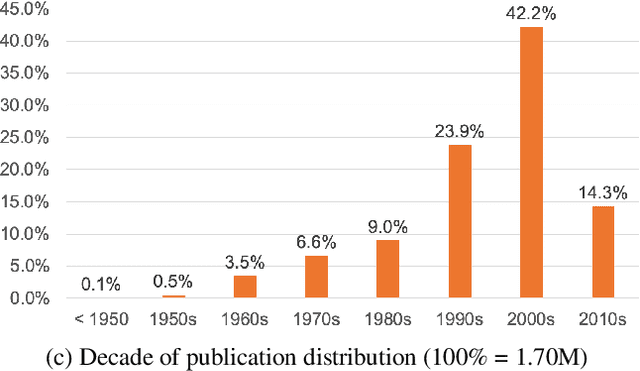
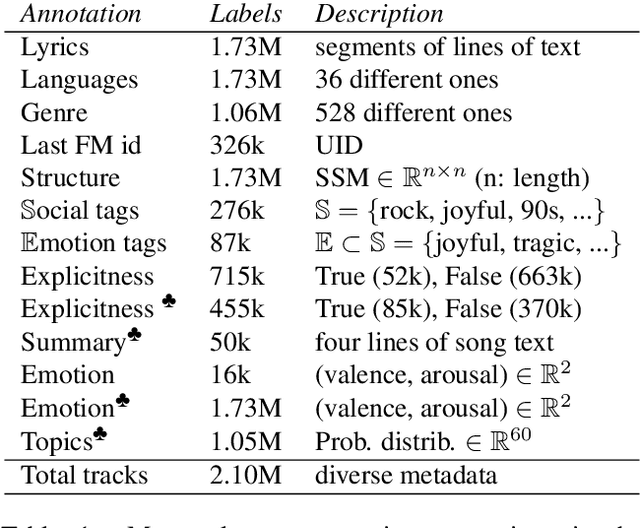
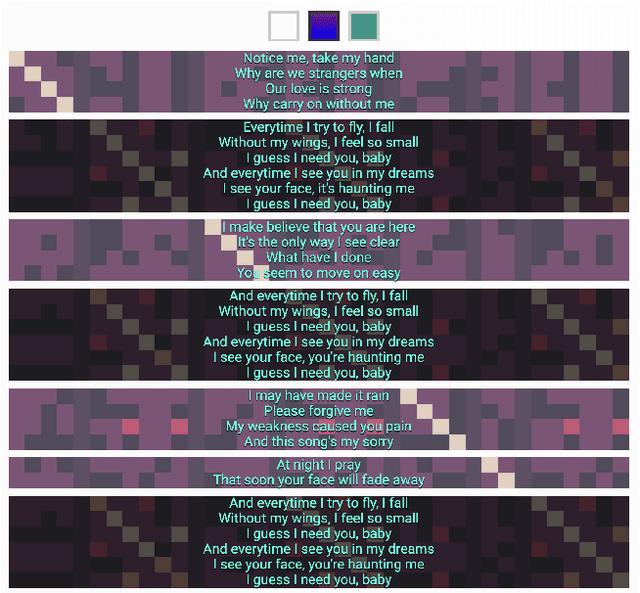
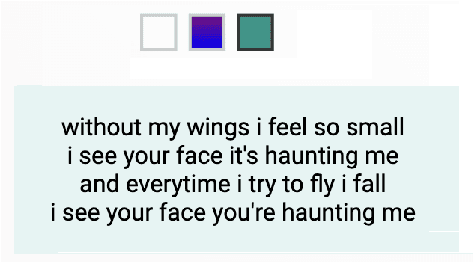
Abstract:We present the WASABI Song Corpus, a large corpus of songs enriched with metadata extracted from music databases on the Web, and resulting from the processing of song lyrics and from audio analysis. More specifically, given that lyrics encode an important part of the semantics of a song, we focus here on the description of the methods we proposed to extract relevant information from the lyrics, such as their structure segmentation, their topics, the explicitness of the lyrics content, the salient passages of a song and the emotions conveyed. The creation of the resource is still ongoing: so far, the corpus contains 1.73M songs with lyrics (1.41M unique lyrics) annotated at different levels with the output of the above mentioned methods. Such corpus labels and the provided methods can be exploited by music search engines and music professionals (e.g. journalists, radio presenters) to better handle large collections of lyrics, allowing an intelligent browsing, categorization and segmentation recommendation of songs.
Graph Data on the Web: extend the pivot, don't reinvent the wheel
Mar 11, 2019Abstract:This article is a collective position paper from the Wimmics research team, expressing our vision of how Web graph data technologies should evolve in the future in order to ensure a high-level of interoperability between the many types of applications that produce and consume graph data. Wimmics stands for Web-Instrumented Man-Machine Interactions, Communities, and Semantics. We are a joint research team between INRIA Sophia Antipolis-M{\'e}diterran{\'e}e and I3S (CNRS and Universit{\'e} C{\^o}te d'Azur). Our challenge is to bridge formal semantics and social semantics on the web. Our research areas are graph-oriented knowledge representation, reasoning and operationalization to model and support actors, actions and interactions in web-based epistemic communities. The application of our research is supporting and fostering interactions in online communities and management of their resources. In this position paper, we emphasize the need to extend the semantic Web standard stack to address and fulfill new graph data needs, as well as the importance of remaining compatible with existing recommendations, in particular the RDF stack, to avoid the painful duplication of models, languages, frameworks, etc. The following sections group motivations for different directions of work and collect reasons for the creation of a working group on RDF 2.0 and other recommendations of the RDF family.
SMILK, linking natural language and data from the web
Dec 20, 2018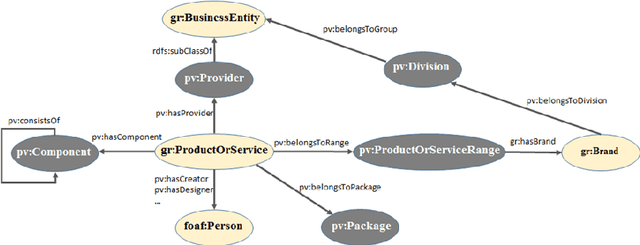
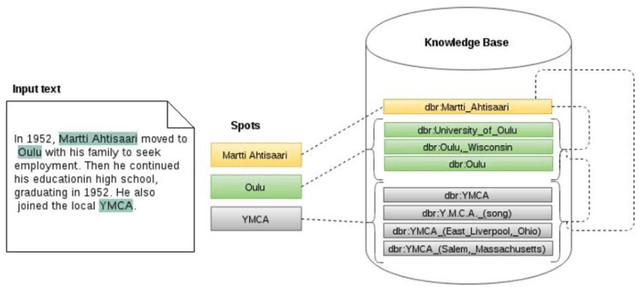
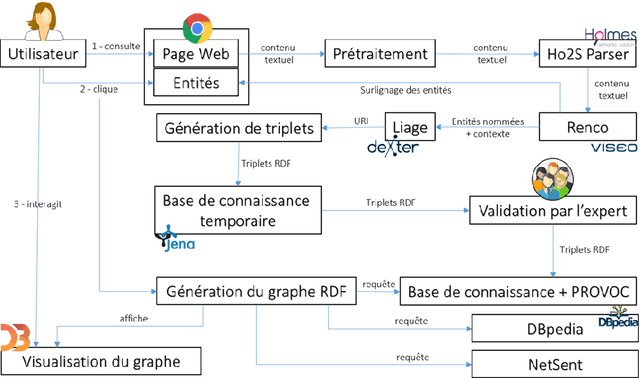
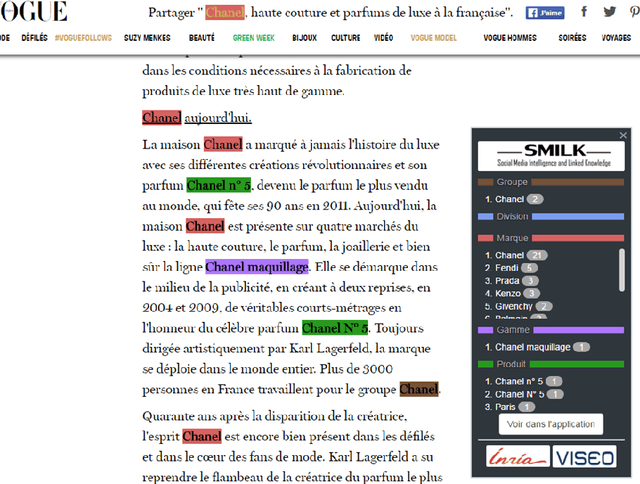
Abstract:As part of the SMILK Joint Lab, we studied the use of Natural Language Processing to: (1) enrich knowledge bases and link data on the web, and conversely (2) use this linked data to contribute to the improvement of text analysis and the annotation of textual content, and to support knowledge extraction. The evaluation focused on brand-related information retrieval in the field of cosmetics. This article describes each step of our approach: the creation of ProVoc, an ontology to describe products and brands; the automatic population of a knowledge base mainly based on ProVoc from heterogeneous textual resources; and the evaluation of an application which that takes the form of a browser plugin providing additional knowledge to users browsing the web.
* in French
ILexicOn: toward an ECD-compliant interlingual lexical ontology described with semantic web formalisms
Apr 24, 2012

Abstract:We are interested in bridging the world of natural language and the world of the semantic web in particular to support natural multilingual access to the web of data. In this paper we introduce a new type of lexical ontology called interlingual lexical ontology (ILexicOn), which uses semantic web formalisms to make each interlingual lexical unit class (ILUc) support the projection of its semantic decomposition on itself. After a short overview of existing lexical ontologies, we briefly introduce the semantic web formalisms we use. We then present the three layered architecture of our approach: i) the interlingual lexical meta-ontology (ILexiMOn); ii) the ILexicOn where ILUcs are formally defined; iii) the data layer. We illustrate our approach with a standalone ILexicOn, and introduce and explain a concise human-readable notation to represent ILexicOns. Finally, we show how semantic web formalisms enable the projection of a semantic decomposition on the decomposed ILUc.
Semantic Social Network Analysis
Apr 23, 2009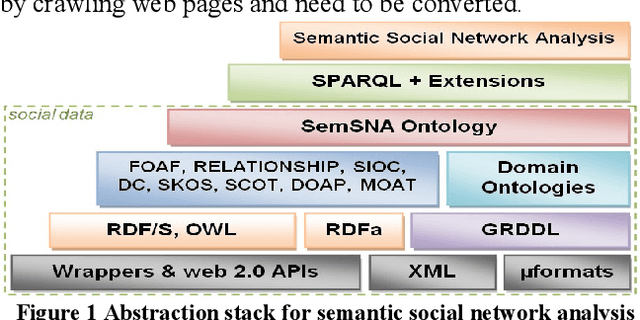
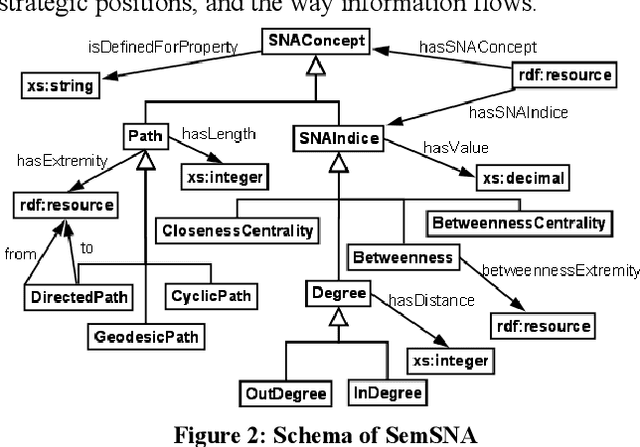
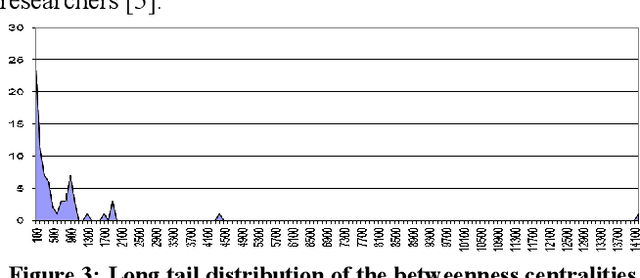
Abstract:Social Network Analysis (SNA) tries to understand and exploit the key features of social networks in order to manage their life cycle and predict their evolution. Increasingly popular web 2.0 sites are forming huge social network. Classical methods from social network analysis (SNA) have been applied to such online networks. In this paper, we propose leveraging semantic web technologies to merge and exploit the best features of each domain. We present how to facilitate and enhance the analysis of online social networks, exploiting the power of semantic social network analysis.
 Add to Chrome
Add to Chrome Add to Firefox
Add to Firefox Add to Edge
Add to Edge